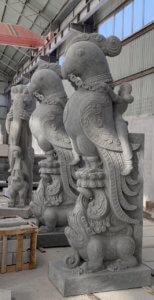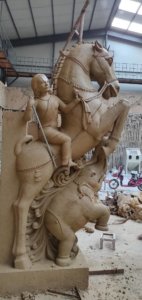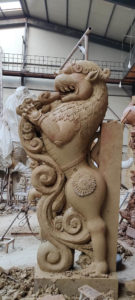A temple is called an aalayam, a place which unites (layam) a soul(athma) with God. Everything you see on the walls of a temple or inside a temple are all aiming at single goal – to unite you with God. The fact is: we are never away from God. But, we have become ignorant of this fact due to arrogance. The arrogance that we are the doers, controllers and recipients of all that is going on in our lives. We don’t accept that the freedom we have is controlled and limited. This arrogance is making us more and more ignorant. Temples and Vedic literature is all aimed at relieving us from this paw of ignorance and giving us a true state of joy!
One of the elements in temples is called, Ya:li. Different types of Ya:li convey some jna:na about ourselves and the Supreme.
Ya:li is an artificial creature structured to show that ‘no matter how strong, smart, powerful, beautiful one may be, all those qualities will flourish in the right way when they are obediently submitted in the service of God’. Ya:li shows how obediently the creature stands in front of the Lord even though it embodies the valour of Lion, mightiness of elephant, dexterity of a crocodile.
These Ya:lis are being structured very beautifully for the Statue of Equality, Centres of Inspiration site. And therefore, Swamiji has taken this opportunity to help us all understand the significance of Ya:li. With details from Chief architect, Prasad Sthapathy Garu – enjoy reading, preserve the meaning in your hearts to share it with all.
 A Suka Ya:li depicts that no matter how greatly skilled one may be in social and spiritual lines of wisdom, one should always seek the refuge of an acharya (one who does not identify him by anything else than a completely devoted tool in the hands of God). A parrot represents a jna:ni and a crocodile represents one who is skilled in social and spiritual aspects. Crocodile is seen to be seeking refuge of parrot…!
A Suka Ya:li depicts that no matter how greatly skilled one may be in social and spiritual lines of wisdom, one should always seek the refuge of an acharya (one who does not identify him by anything else than a completely devoted tool in the hands of God). A parrot represents a jna:ni and a crocodile represents one who is skilled in social and spiritual aspects. Crocodile is seen to be seeking refuge of parrot…!
 An Ashwa Ya:li shows that even if one is physically stout, only a jna:ni is greatly agile in leading his life well. Physically stout is seen in the elephant and the greatly agile jna:ni is represented by a horse. The form of Srimannarayana, Hayavadana is an example of how horse face indicates the fast paced jna:ni
An Ashwa Ya:li shows that even if one is physically stout, only a jna:ni is greatly agile in leading his life well. Physically stout is seen in the elephant and the greatly agile jna:ni is represented by a horse. The form of Srimannarayana, Hayavadana is an example of how horse face indicates the fast paced jna:ni
 A Simha Ya:li shows that even if one is cruel in heart and in actions, an acharya’s grace can turn one to speak soft, gentle like that of beautiful flowers. This creature shows the Lion giving out flowers from its mouth.
A Simha Ya:li shows that even if one is cruel in heart and in actions, an acharya’s grace can turn one to speak soft, gentle like that of beautiful flowers. This creature shows the Lion giving out flowers from its mouth.
The temple architecture not only shows extremely delicate, intricate and highly enriching skilful artisan work but also beautifully depicts internal essence from Vedas about behavioural and spiritual aspects for any aspirant.

